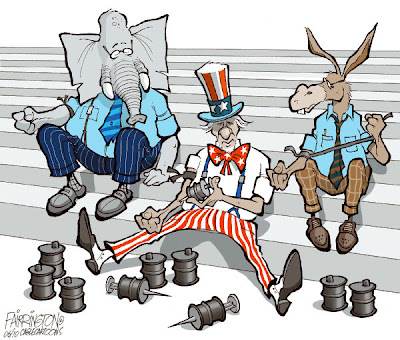Places like Kansas City and St. Louis try to claim some kind of ownership to barbecue. I'm sorry... but it started in Texas. The cattle were raised here and delivered there, so it only makes sense that all things beef had their genesis in Texas.
Barbecue as we know it is rather new to this world, with roots barely older than 100 years. There is evidence suggesting that German immigrants to Texas in the late 1800's/early1900's, while trying to find ways of cooking beef brisket to make it more palatable, just might be how closed pit, smoked bar-b-cue came about.
In the late 19th century, around the time that the Texas cattle industry was booming, German immigrants were taking the lead in preparing and cooking beef. The Germans fit in naturally because of strong butchering and sausage-making history. As good butchers will do, these German immigrants sought whatever means possible to make use of every scrap of the beef carcass, including the cheaper, most useless, and most unpalatable cuts.
Beef brisket fits that description. The cut is as tough as skirt and has a very high fat content to boot.
Thus brisket historically was never been a beloved cut. Cooking a brisket by any of the common means resulted in something only barely edible. Rather than cooking over an open fire, more often it was boiled or pickled into the old-world corned beef. Boiled beef sucks, and corned beef was never a a Texas favorite, so it was often just fed to the dogs.
Well, we don’t feed it to the dogs these days. There is a whole subculture grown up around Texas barbecue, but wannabes from around the county still spin history to make it appear as if their poor excuse is the real thing.
Sorry folks, but history wins this one. Texas is the home of real barbecue.
Historically meat was cooked over open fires. Pits in the old days were simply some kind of bowl with a fire built in the bottom, and a spit or grate over them. In the late 19th and early 20th century the Texas German community started cooking this otherwise useless cut of meat slowly on pits with lids, under low heat, and not directly over the fire. The high fat content simmered in the low heat and melted away slowly, keeping the meat from drying out and leaving only tender beef with a wonderful smoky flavor.
This worked, and the only argument at that time revolved around which tree produced the best smoking wood.
Other than the rubs, nothing much has changed to this day. Closed pit, slow smoking remains the way to achieve a great beef brisket. You don't really need spices, seasonings, or rubs because of the flavor is naturally in the meat, but a good rub will help you win fans and contests.
So, in the public interest, I’d like to offer my recipe for Texas dry rub barbecue brisket.
Smoking a brisket is a slow process, so you should plan to start cooking the evening before. Depending on the size of your smoker you can do more than one brisket at a time. I have a big one capable of doing ten at the same time. The process is slow, and you’re cooking more with smoke than heat, so the more meat the merrier.
My favorite smoking wood is pecan, but mesquite and apple are good too. Hickory, while a favorite of many, fails to meet my expectations. In the end the only real criterion is that the wood be of the hardwood variety. Pine makes sucky BBQ.
Maintenance of the fire is imperative. The brisket will be under heat for up to 18 hours, and under smoke for at least the last six hours, so the heat level must remain constant over the entire time. Your target temperature is 180 degrees, so plan to babysit the fire overnight, having a good supply of charcoal and a fair supply of wood on hand before starting.
You'll actually have two fires. Build your first with charcoal alone. If possible avoid using starter fluid, but if you use that noxious stuff be sure it has burned off before starting the next step.
While the fire is settling down you should prepare your meat. Start with a 7-10 pound untrimmed beef brisket. This time of year is the best time to buy brisket, as many of the grocery stores offer sales on the traditional Independence Day fare. You’ll find the best prices in the Kroger at 99 cents a pound (usually limit two with a minimum purchase). Look for a slab that is nicely fatty on one side and bloody red on the other. Never buy a trimmed brisket.

Rub the brisket thoroughly with the dry rub (recipe below), wrap in heavy-duty aluminum foil (I like to double wrap to ensure a good seal), fat side up. To add a bit of the familiar, I like to drape several thick slices of bacon over the brisket before wrapping.
Place the wrapped brisket in the pit for about 12 hours. Keeping the moisture in the meat is important, so be certain you have a good wrap. Check your temperature frequently to ensure you maintain 180 degrees.
After 12 hours have passed, peel the foil open and remove the bacon, exposing the meat directly to the heat (you can eat the bacon now, but you need a beer to go with it.)
Start tossing some of the soaked pecan wood onto the coals and watch the smoke start to rise. Close the pit and leave it closed. Every time you open the lid you let smoke escape and the temperature suffers. In about six hours you’re ready to pull the brisket off the rack and enjoy a real, tasty treat.
You've been cooking mostly with smoke for these six hours, so you’ve got to make your wood smoke as much as possible when burning. My way of accomplishing this is to soak the wood in a trough of water prior to placing it in the firebox. Make sure you have a bed of good charcoal, get it burning good and hot, then place the soaked wood on top. To maintain sufficient moisture in the meat I set a pan of water on the edge of the fire. The steam from the water helps keep the meat hydrated.
Like I mentioned earlier, even without a rub the brisket, if prepared in this manner is very tasty. The fat boiling off adds the majority of the flavor and the bacon certainly doesn’t hurt, but a good rub adds your personal signature. Throughout history, barbecue chefs have created signature rubs, and then taken that recipe to the grave. I have no intention of following suit. Here is mine.
Brisket Rub ala Phudpucker - (also useful for pork butt or loin)
RULE #1 – Use fresh ingredients. Stuff in cans, bottles or jars bought off of shelves may be old and losing flavor. Using the freshest and highest quality you can locate will improve the outcome, and keeping a grinder around so you can process your own promotes the highest quality product.
These are the spices I use, and the ratio in which they are added. Make the recipe as large or small as needed, and then toss any leftovers. They don’t keep well.
- Raw, brown sugar – 16 to 1
- Salt – 6 to 1
- Dried garlic – 2 to 1
- Dried onion – 2 to 1
- Dried ancho chilies – 2 to 1
- Cumin seed – 2 to 1
- Annatto seed – 2 to 1
- Fine grind black pepper – 1 to 1
- Cayenne pepper – 1 to 1
- Coriander seed – 1 to 1
- Thyme – 1 to 1
So now go forth, make plenty big smoke (you’d be surprised how this helps get girls), then feed the naked and the unwashed with the nectar of the gods. Enjoy.
~~





































































